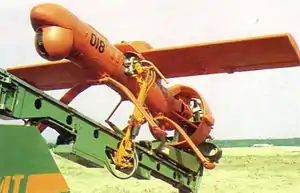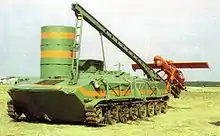| Pchela | |
|---|---|
 | |
| Pchela-1T UAV on a starting ramp (closeup view) | |
| Role | Unmanned air vehicle |
| National origin | Soviet Union/Russia |
| Manufacturer | Yakovlev |
| First flight | 1986 |
| Primary user | Russian Air Force |
The Yakovlev Pchela-1T ("Пчела" meaning bee) is an unmanned aerial vehicle (UAV) manufactured by the Russian Yakovlev Design Bureau. Its primary use is for surveillance and observation in battlefield environments with downlinked video. Other implementations and uses include target designation and as a training target.
Design

Pchela-1T UAV on a BTR-D launcher
The Pchela is launched using rocket assist by two solid-propellant booster rocket engines, and it is recovered via parachute. The Pchela-1T has a range of 60 km (37 mi), flies at 100–2,500 m (330–8,200 ft) altitude at 120–180 km/h (75–112 mph). The maximum takeoff weight for the vehicle is 138 kg (304 lb). Yakovlev lists the vehicle endurance at two hours.
Operators
References
- ↑ The Military Balance 2016,p.190
- ↑ The Military Balance 2016,p.266
- ↑ "Внутри тайной программы БПЛА Северной Кореи « TodaysMilitary. Информатор о военных действиях". Archived from the original on 2017-06-30. Retrieved 2016-08-20.
External links
Wikimedia Commons has media related to Yakovlev Pchela.
This article is issued from Wikipedia. The text is licensed under Creative Commons - Attribution - Sharealike. Additional terms may apply for the media files.